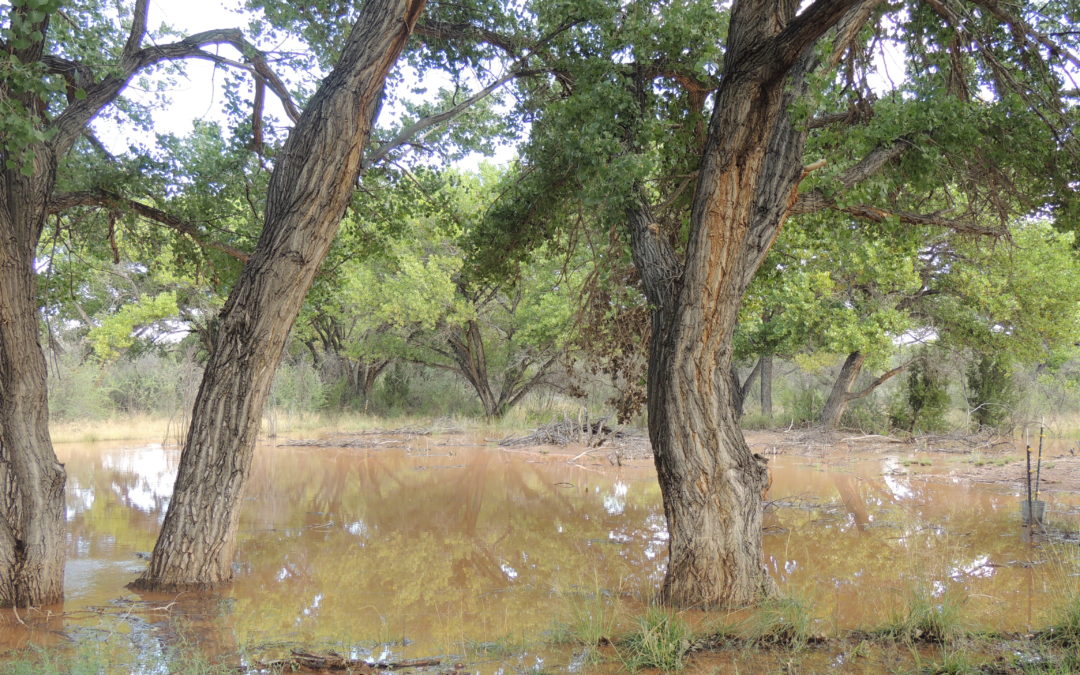Matthew and Stephanie Mitchell live on 18 acres of land alongside the banks of the Rio Grande in Socorro County, New Mexico. Stepping onto the front porch of their small passive solar home, you are greeted by the sounds of a healthy Cottonwood-Willow gallery forest: rustling leaves, singing birds, and the faint whisper of spring winds. A Vermillion Flycatcher flutters down from the canopy and mesquite cones hang daintily from their stems, waiting to be nibbled upon by a passing deer. While the Mitchell’s have not always called this place home, they feel happy and fulfilled here. The tranquility of the surrounding bosque is a refuge from the monotone rumble of urban centers like Albuquerque and Belen where Matthew and Stephanie once lived and raised their two, now-grown children. The flickering light of sunshine pours through the forest canopy, inspiring their small handcrafted jewelry business and supporting Matthew’s favorite hobby, falconry. This land also provides the Mitchell’s with an opportunity to practice another of their lives’ passion: collaborative land stewardship with local conservation and restoration organizations like RGALT and the Save Our Bosque Task Force (SOBTF).
Today, Matthew and Stcphanie’s land is characterized by diverse plant and animal species that are native to New Mexico. However, this has not always been so. In 1998, when Matthew and Stephanie decided to move away from Belen and purchase their plot of land alongside the Middle Rio Grande, they were excited by the opportunity to become stewards of the river and bosque. They were also humbled by the task before them.While the property had a well-established Cottonwood gallery forest in 1998, invasive species including Tamarisk and Russian olive were quickly choking the understory. Walking beneath the towering Cottonwood canopy on a cool spring morning in 2017, Matthew reminisces about the early days of living on this land, “when we first moved here, you couldn’t see more than 20 feet past our front step because the Tamarisk was so dense! Look at it now! You can see until the end of our property line!” Walking through the understory today, it is hard to imagine this place as a dense, impassable forest characterized by thriving invasive vegetation.
In 2001, Stephanie and Matthew decided that something had to be done to mitigate the expansion of the monotypic Tamarisk stands that were increasingly degrading the health and vitality of their stretch of the Middle Rio Grande ecosystem. They applied for and received a grant from the Fish and Wildlife Service’s Partners for Fish and Wildlife Program and immediately began the task of habitat restoration. They removed a large portion of the mature Tamarisk and Russian olive trees on the property, excavated a groundwater pond for wildlife like mountain lions and coyotes, and began the slow, arduous process of restoring the open, biodiverse understory that historically characterized the Middle Rio Grande bosque. In 2004, following this initial effort, the Mitchell’s volunteered their land to the Save Our Bosque Task Force as a pilot site for a restoration model that could be shared with other conservation-minded private landowners in the area. To support this effort, the SOBTF received a Bosque Initiative Grant from the Fish and Wildlife Service (FWS), which provided sufficient funding to manually and mechanically remove the remainder of invasive trees on the Mitchell’s property. The residue from the treatment was mulched and spread across the forest floor and in 2015-16, another grant from the FWS Partners program provided the Mitchell’s and collaborating organizations with funding to replace the cleared invasive vegetation with an assortment of native trees and shrubs.
Strolling through their stretch of the bosque today, Matthew and Stephanie are proud to point out the dead Tamarisk tree stumps and overall lack of invasives, which provide evidence of the conservation and restoration work they have diligently undertaken over the past 15 years. Matthew points to an adjacent field about a quarter mile down the road and identifies a dense, untreated patch of Tamarisk that emerged over the past few decades, “That would have been us if we hadn’t been able to do what we’ve done.”
As they sit around their kitchen table recounting how their lives and the surrounding bosque have evolved on this land since 1998, Matthew and Stephanie reveal that they are unsure whether or not their two grown sons will one day choose to return to New Mexico to live on this land and practice stewardship as they have done. Yet, motivated by their shared belief in the cultural and ecological value of the Rio Grande and the adjacent bosque, Matthew and Stephanie decided to engage their sons in a candid conversation about their intention to have this land forever protected from development and degradation. In 2014, the Mitchell’s formalized this commitment by signing a conservation easement with the Rio Grande Agricultural Land Trust. This decision solidified their corner of the Middle Rio Grande as one more protected patch of land in an expanding mosaic of conserved and restored areas in the valley. With this effort, the Mitchell’s are helping to connect the dots of protected and restored areas up and down the riparian corridor of the Middle Rio Grande. This effort, and others like it, breathe life into a shared vision of a healthy, biodiverse Rio Grande that supports the livelihoods of plant, animal, and human communities for this generation and those yet to come.
Article written by Hanes Motsinger, RGALT Intern

